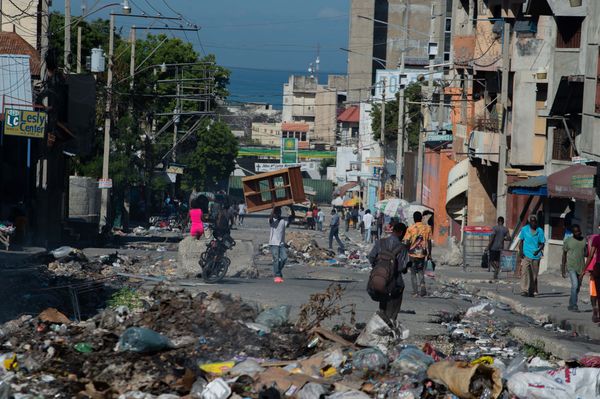
It’s not often that you discover a new species in your lunch spot. But for Lou Jost, co-founder and director of Fundación EcoMinga, that’s exactly what happened. Everything from a new species of glass frog to a new mammal genus have been discovered on the Ecuadorian reserves that Fundación EcoMinga protects with funding from the conservation charity World Land Trust – but it all began with orchids.
“When you’re sitting still, you observe things much more carefully,” says Jost. “I saw all these leaves that I recognised as orchid leaves.” Turning them over, he found flowers that “looked more like insects”, counting five different orchid species without leaving his spot. “It opened my eyes to the biodiversity of these orchids,” says Jost, and on a later hike to the same area, he spotted something strangely beautiful he’d never seen before – a brand new species. “I named it Lepanthes elytrifera, which means ‘carrying beetle wing covers’, because the centre of the flower looks like a pair of shiny beetle wing covers.”
But to Jost, who’d been fascinated with orchids since childhood, even growing a DIY rainforest in his basement, it was obvious that this new species was threatened. “From where I was sitting, I could hear the sound of chainsaws.”
Over the next decade, while Jost mapped out the patterns of orchid biodiversity, he felt an obligation to ensure the survival of these areas and their endemic species. He approached the local government and the body responsible for managing Ecuador’s national parks, but “kept running into brick walls”. So, in 2005, he and a group of Ecuadorian and international scientists and conservationists founded Fundación EcoMinga, with “some small reserves and small donations”. But scaling up was an issue – until World Land Trust stepped in, when he approached it for funding to protect 2,000 hectares (4,900 acres) of vital habitat. “Almost immediately, they agreed,” he says.
World Land Trust has funded the protection of 29,036 hectares of land in Ecuador through its partners. EcoMinga alone manages 10 reserves in the upper Río Pastaza watershed, a biological corridor linking the northern and southern ranges of Ecuador’s eastern Andes. There, it has discovered nearly 100 species, almost all of which are found nowhere else but the watershed. EcoMinga also manages two more reserves in the Chocó region of north-west Ecuador, and it is here that one of its recent mammalian discoveries took place.
Discovering Pattonimus
Rodents are often overlooked in science, says Jost. But Ecuadorian mammologist Jorge Brito knows only too well the hidden biodiversity they represent. Alongside EcoMinga’s executive director, Javier Robayo, and “highly trained, highly motivated guards from Baños de Agua Santa”, Brito led an expedition to the Dracula reserve in the Chocó region, near the Colombian border, to investigate the amphibians, reptiles and mammals in the area. As a result of the expedition, the researchers identified a new species of rodent. “We knew that what we found was probably a new species,” he says. But it was the morphology of its teeth that led the team to understand they had actually discovered a new rodent genus, Pattonimus. “Even globally, that’s quite rare.”
Discoveries on World Land Trust-funded reserves include the Norma Ewing’s rain frog, identified last year by EcoMinga’s reserve manager, Juan Pablo Reyes-Puig,during a research expedition to Cerro Candelaria. And announced this year, the luminous green Maycú torrent frog, discovered where the Andes meets the Amazon in the Maycú reserve by a team of researchers.
In 2020, the ethereal, translucent-skinned mindo glass frog was also rediscovered in EcoMinga’s Rio Manduriacu reserve, seen just twice in the wild since it was first described in 1975. The reserve, originally intended to protect the critically endangered Tandayapa Andean toad, is now a breeding ground for these otherworldly creatures. Another is the scorpion species discovered during a community patrol by Asociación Ecológica de San Marcos de Ocotepeque in western Honduras, and named Centruroides lenca in honour of the Indigenous Lenca people.
Finding amphibians
“It is really hard to discover new species … but not as hard as I thought,” says Jost, recalling his favourite find on an expedition to a remote, little-studied mountain in the World Land Trust-protected Machay reserve.
“It’s a very special mountain, very steep – almost nobody has ever been,” says Jost, who was ascending with a team when a guard named Darwin Riccardo came running with something in his hands. “A big black frog with fluorescent dots all over it. Such a crazy frog. I had no idea there was anything like this in the world!” Riccardo had spotted it inside a bromelia plant. “It still blows me away!”
A frog by any other name
And as for the name of that thrilling spotted frog? Hyloscirtus sethmacfarlanei, named in honour of the actor Seth MacFarlane, who also works to halt the loss of rainforest habitat. “You can do a lot with new species. They’re attention-getters. There are actually websites that track things that are named after David Attenborough,” he says, adding that he, too, has named a plant after Attenborough, a World Land Trust patron – the Blakea attenboroughii.
“I often name species after people or communities,” says Jost, recalling how an orchid named after the city of Tulcán in Ecuador made the news. “The city printed colourful children’s books with pictures of all the fancy frogs, birds and plants, and the garbage collectors handed them out,” he says. Tulcán even painted its municipal vehicle to match.
Sharing that curiosity and pride on a global scale could be a tonic for anyone feeling despondent about the loss of natural habitats. Jost insists there’s room for optimism. “Every significant ecosystem in the Río Pastaza watershed of Ecuador is now at least partly preserved by these reserves.” And EcoMinga’s reserves are growing, protected rigorously by World Land Trust’s Keepers of the Wild rangers.
“All of the World Land Trust’s partners are an inspiration for the world. The diversity here is so high that you can’t just pay attention to one area,” says Jost. “You’ve got to have one decentralised system of partners focusing on different animals and plants and areas – and that’s what World Land Trust does. And it’s working.”
You can support projects like the Rio Anzu Reserve by donating to the World Land Trust Action Fund – conservation where it’s needed most







